Key Plant: Juniper (Juniperus spp.)
Juniper species (Juniperus spp.) are evergreen species that vary in size, ranging from groundcover plants all the way up to large trees. Junipers provide many uses to satisfy different needs in the landscape. In Florida, only red cedar (Juniperus virginiana) is native, while others are used as ornamentals in the landscape. Junipers are a popular landscape plant across the United States, with a cold hardiness allowing them to thrive in USDA Hardiness Zones 2 through 9. These species are noted for their interesting foliage, which in their mature form is described as scale-like. Their color tends to be a darker green but can have a blue-gray tint. Most in this genus require full sunlight for optimum growth. The tree produces a blue fruit-like structure resembling a berry with round or oval shapes, although it is actually a small cone. Junipers are fairly drought and salt resistant, mainly because they have strong lateral roots; therefore, junipers can be used for landscaping in areas with harsh environmental conditions and poor soil (UF/IFAS Gardening Solutions 2018).
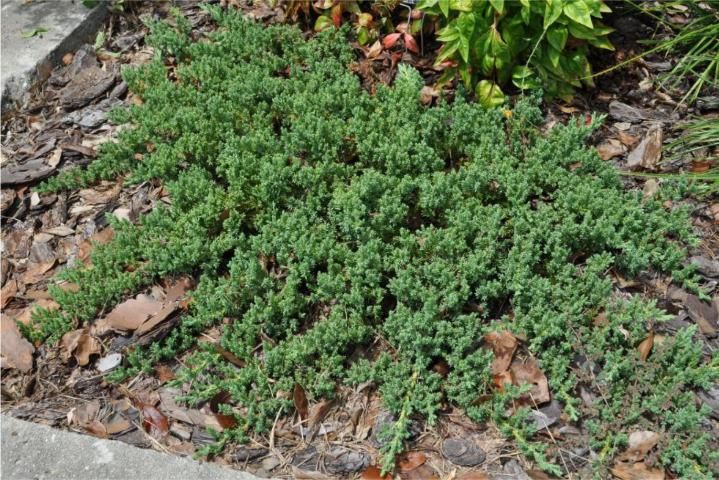
Credit: Alicia Lamborn, UF/IFAS
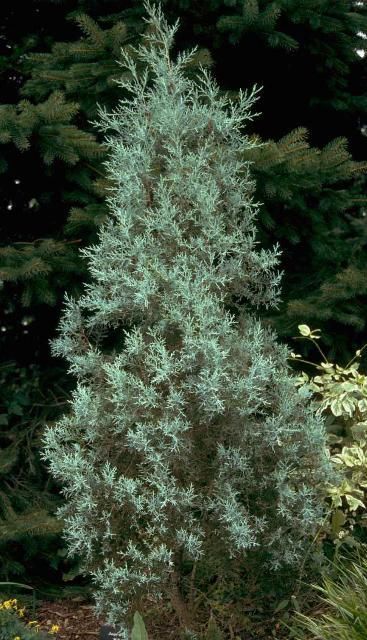
Credit: Ed Gilman, UF/IFAS
Key Pests: Juniper (Juniperus spp.)
This series of Key Plant, Key Pests publications are designed for Florida gardeners, horticulturalists, and landscape professionals to help identify common pests associated with common Florida flora. This publication, the ninth in the Key Plant, Key Pests series, helps identify the most common pests found on juniper.
This publication provides information and general management recommendations for bagworms, eriophyid mites, scale, spider mites, webworm, mushroom root rot, needle blight, Rhizoctonia web blight, tip blight, and wet root rot diseases. For a more comprehensive guide of woody ornamental insect management, download the current Professional Disease Management Guide for Ornamental Plants or the Integrated Pest Management in the Commercial Ornamental Nursery Guide.Additionally, the 2017 Southeast Pest Management Guide may provide specific chemical recommendations for controlling pests.
Bagworms
Recognition
Bagworms are small caterpillars that glue foliage and debris together to make a spindle-shaped covering bag. As they grow, bagworms add to this bag, which can measure up to two inches long. The caterpillars live in the bag and emerge from one end to eat foliage. Large populations can defoliate plants. Female moths cannot fly, but the larvae will disperse, sometimes by "ballooning" in the wind on silken fibers.
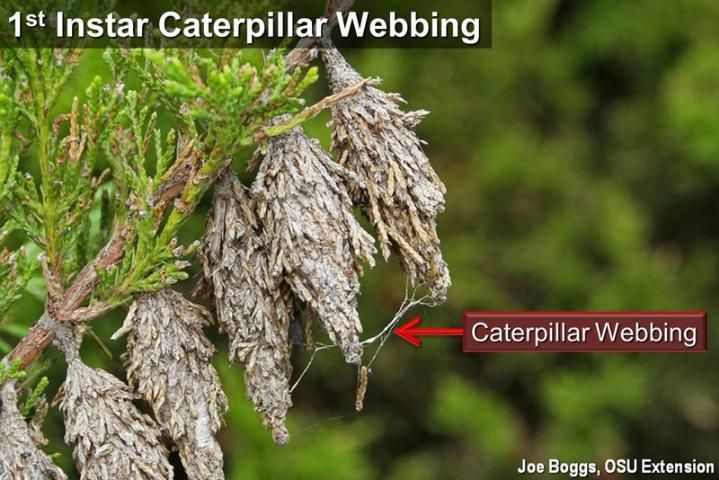
Credit: Joe Boggs, Ohio State University
Contributing Factors
Previous infestations.
Management Recommendations
To control bagworm, use sprays of or pick off the insects from the plants by hand, depending on infestation numbers and height of the plant (Potter and Townsend 2010).
Eriophyid Mites (Trisetacus quadrisetus)
Recognition
Eriophyid mites are microscopic, elongated, spindle-shaped, and translucent. Though the leaf galls they cause are apparent, the mites are difficult to see because they are not visible to the naked eye. In fact, the mites may leave, but the gall may continue to grow. These mites possess chemicals in their salivary secretions that act as growth regulators. Plant galls develop from epidermal cells on young leaves that are affected by injected growth regulators during development.
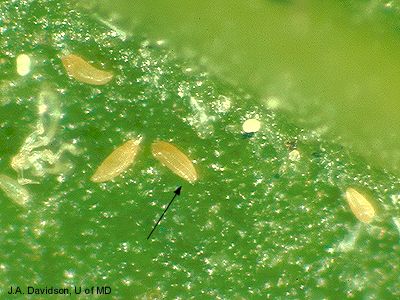
Credit: J. A. Davidson, University of Maryland
Contributing Factors
These mites are not as common on juniper. Areas that have been previously infested are more prone to infections.
Management Recommendations
Scout and remove affected plants or plant parts as soon as possible. There are biological controls available. Be sure to rotate the mode of action of any chemical used (Osborne n.d.).
Scale (Several Species)
Recognition
Scales are piercing sucking insects that suck the sap from plants, sometimes causing serious damage and dieback, but sometimes just causing the plant to look dirty. Soft scales excrete "honey dew" on which black sooty mold grows. Armored scales do not excrete sooty mold and so may be more difficult to detect at low populations. Maskell scale (Lepidosaphes pallida) and minute cypress scale (Carulaspis minima) are the most common on juniper. Juniper scale (Carulaspis juniperi), minute cypress scale, and Maskell scale are armored scales.
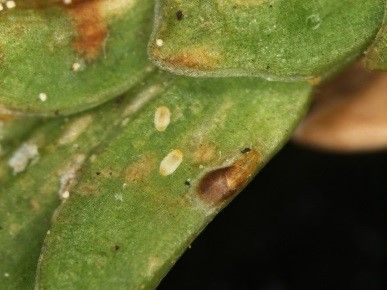
Credit: Sabrina Tirpak, Rutgers University
Contributing Factors
Application of persistent broad-spectrum insecticides may inhibit predators.
Management Recommendations
Prune off heavily infested branches. Biological controls, predatory insects, and parasitic wasps may be available. Rotate use of chemicals and target crawlers with contact insecticides. Systemic chemicals will be most effective on adults (Beckley 2013).
Spider Mites
Recognition
Tiny (less than 1/50 inch) eight-legged mites are found most commonly on the undersides of leaves. Eggs, cast skins, and silken webs are also signs of mites. Mites feed with piercing-sucking mouthparts, causing the foliage to become pale or off-color. Common mite pests of junipers include two-spotted spider mites (Tetranychus urticae), spruce spider mites (Oligonychus ununguis), and southern red mites (Oligonychus ilicis).
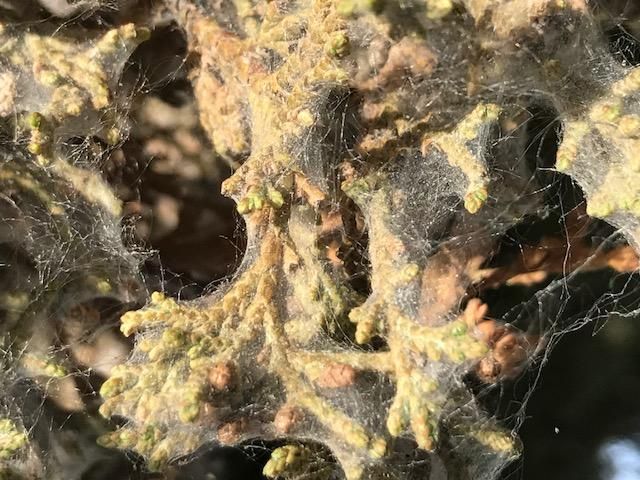
Credit: Amy Seiler, Nebraska Forest Service

Credit: Lance Osborne, UF/IFAS
Contributing Factors
Southern red mites and spruce spider mites are most prevalent in the cool season, whereas two-spotted spider mites prefer hot, dry weather. Mites have multiple generations per year, although numbers are highest during their respective seasons.
Management Recommendations
Knock branches against a white piece of paper to monitor for mites. Check for predaceous mites as well, which are larger and move more quickly. Insecticidal soaps, horticultural oils, or approved miticides may be used to control mites when necessary.
Webworm (Daeborneris marginella)
Recognition
Symptoms show up in the spring as the death of individual stems, which turn red in color. The damage is caused by webworm caterpillars, which are about ½ inch long and tan to dark brown in color. The foliage and soil particles at the base of the plant may be held together by webbing. The caterpillars feed on dead or living foliage, but during the winter they will feed on bark and girdle the stem (Schuster 2018).
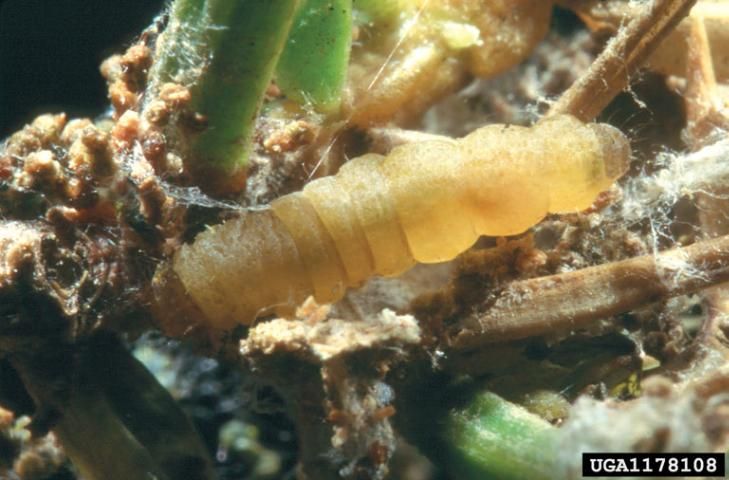
Credit: Connecticut Agricultural Experiment Station,
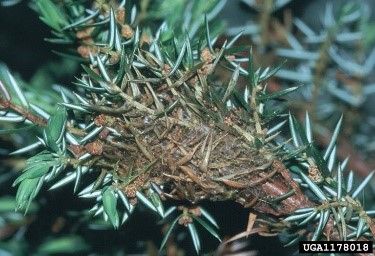
Credit: Connecticut Agricultural Experiment Station,
Contributing Factors
This pest primarily infests spreading or low-growing, ground-cover types of junipers. The girdling damage occurs only during the winter, but symptoms are not evident until spring.
Management Recommendations
Remove dead branches at the base. Apply an insecticide to control larval populations in the fall only if this pest has been a problem in previous years. There are several natural predators of juniper webworm.
Mushroom Root Rot (Armillaria tabescens)
Recognition
Mushroom root rot causes a slow decline and thinning of the plant canopy, eventually leading to plant death. It is a fungus that decays the root system of plants. Desiccated foliage on affected stems has a gray-green discoloration, which then turns brown. One or more stems may be killed. Bark removal at the base of the plant will reveal white, mat-like fungal growth (mycelium). Clusters of honey-colored mushrooms can sometimes be observed emerging from the trunk or roots nearby.
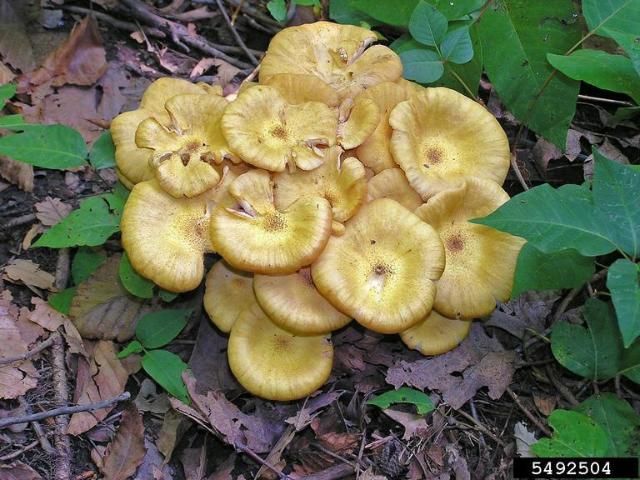
Credit: Curtis E. Young, Ohio State University,
Contributing Factors
Mushroom root rot is a wood-decaying rot fungus that colonizes old roots and stumps as well as living parts of plants. This disease often occurs when plants reach old age. It can spread from one plant to others nearby through root grafts. Moist conditions enhance the development of the fungus. Stressed plants are at a higher risk of being infected.
Management Recommendations
There is no control for this disease. Remove the diseased plant as well as adjacent ones in a hedge. Remove roots and soil and replace with clean topsoil or use a soil fumigant before replanting (UF/IFAS Gardening Solutions 2017).
Needle blight (Pestalotiopsis sp.)
Recognition
This fungus enters the new shoot tips or wounds and causes shoot and branch browning and dieback. Stems, small branches, and needles can be affected. The fungus can survive in a dormant state within the plant. It produces pads of fungal tissue underneath the epidermis that will rupture through and produce long black masses of spores when moisture is abundant. Spores may be blown or splashed onto healthy plants nearby to spread infection.
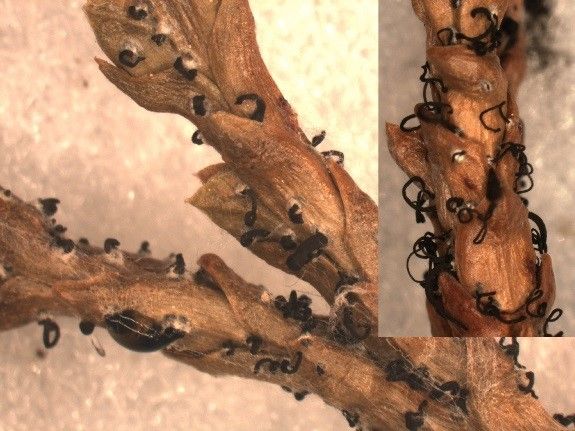
Credit: Nicholas J. Brazee, University of Massachusetts
Contributing Factors
Pestalotiopsis attacks plants already weakened by stress from drought, mechanical injury, insect infestations, and transplant shock.
Management Recommendations
Prune and discard any affected plant parts. Avoid pruning during wet weather and overhead irrigation. Fungicides may be used preventatively after pruning and after known infections have been found and removed (Brazee 2016).
Rhizoctonia Web Blight (Rhizoctonia solani)
Recognition
Web blight on junipers appears as random areas of dead foliage. Both old and new growth are involved. The threadlike strands of fungal hyphae can be seen with a 10x hand lens and should not be confused with spider mite webbing, which would have mites on it.
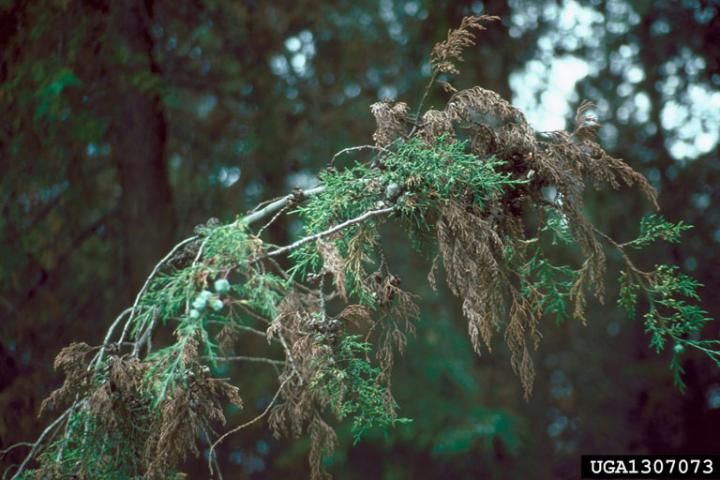
Credit: Robert L. Anderson, USDA Forest Service,
Contributing Factors
The aerial blight phase of Rhizoctonia is favored by hot summer temperature and ample water. The fungus is soilborne but splashes up into the foliage to initiate web blight. The same fungus may cause root rot or stem rot and affects many ornamental plant species.
Management Recommendations
Minimize overhead irrigation on juniper beds. Prune to improve air circulation and enhance drying out. Fungicide applications may be needed for control.
Tip Blight (Phomopsis juniperivora)
Recognition
New growth is affected, with the tips turning light gray-green, then tan, and finally ashy gray. Disease progresses from the tip backwards and may cause small branches to die. Small black reproductive structures of the fungus may be visible with a hand lens.
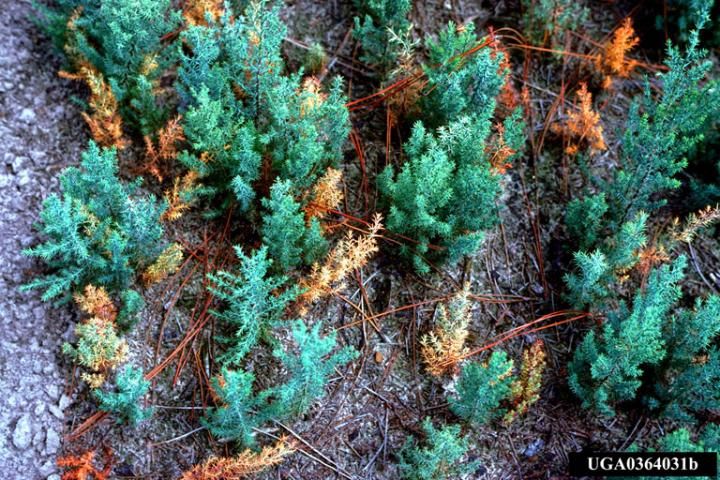
Credit: Robert L. Anderson, USDA Forest Service, Bugwood.org
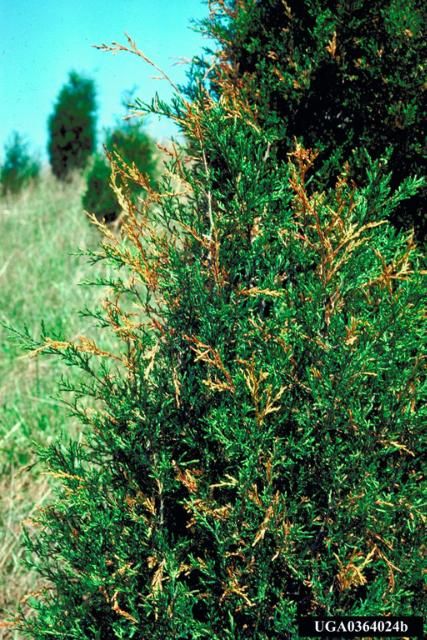
Credit: Robert L. Anderson, USDA Forest Service, Bugwood.org
Contributing Factors
Tip blight usually affects only young plants. The disease may follow other stresses such as mites or pesticide phytotoxicity. High humidity and cool temperatures (<75°F) are necessary for spore germination, but disease development is promoted at higher temperatures (79°F‒90°F).
Management Recommendations
Landscape plants will usually outgrow the disease. Damaged branches can be pruned out. New plantings may be protected with fungicide applications when environmental conditions are favorable for the disease (Pataky 2007).
Wet Root Rot Diseases (Phytophthora and Pythium spp.)
Recognition
Junipers first exhibit off-color foliage, pale green progressing to yellow to brown. The plants die from the inside out, with the oldest foliage affected first. Aboveground symptoms may be one-sided on the plant. Wet rots cause a soft decay of the outer layers of roots, which can be easily stripped off between two fingers, leaving the firm, white stele intact.
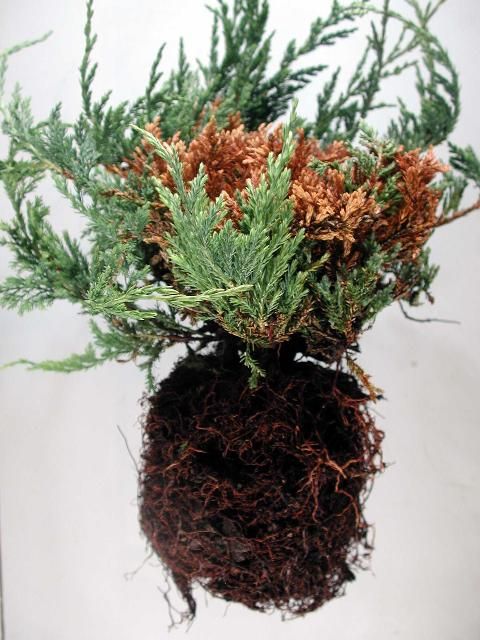
Credit: Melodie Putnam, Oregon State University Plant Clinic
Contributing Factors
The disease is triggered by periods of excessive soil moisture. Conditions that favor disease development include planting too deep, poor drainage, shallow rooting, and poor water management.
Management Recommendations
Check roots of nursery-grown plants before planting into the landscape and look for signs of wet root rot. Roots will easily pull apart and outer layers will strip off, as described above. Provide adequate drainage and reduce irrigation. Apply fungicides labeled for wet root rot if the problem is diagnosed early and cultural problems corrected.
References
Brazee, N. J. 2016. "Arborvitae needle blight." https://ag.umass.edu/landscape/fact-sheets/arborvitae-needle-blight
Buckley, R. 2013. "Maskelled bandit." https://plant-pest-advisory.rutgers.edu/maskelled-bandit/
Mizell, R. F., and D. E. Schiffauer, D. E. 1987. "Evaluation of insecticides for control of Glyphidocera juniperella (Lepidoptera: Blastobasidae) in container-grown juniper." The Florida Entomologist.70(3): 216‒230. https://www.jstor.org/stable/3495064
Osborne, L., R. D. Oetting, and J. H. Chong. n.d. "Mites." https://mrec.ifas.ufl.edu/lso/miteweb/MITES.pdf
Pataky, N. 2007. "Phomopsis twig blight of juniper." http://hyg.ipm.illinois.edu/pastpest/200707b.html
Potter, M. F., and L. H. Townsend. 2010. "Bagworms on landscape plants." https://entomology.ca.uky.edu/ef440
Schuster, J. 2018. "Juniper webworm." http://extension.illinois.edu/focus/index.cfm?problem=juniper-webworm
UF/IFAS Gardening Solutions. 2017. "Armillaria root rot." https://gardeningsolutions.ifas.ufl.edu/care/pests-and-diseases/diseases/armillaria-root-rot/
UF/IFAS Gardening Solutions. 2018. "Junipers." https://gardeningsolutions.ifas.ufl.edu/plants/trees-and-shrubs/shrubs/junipers/